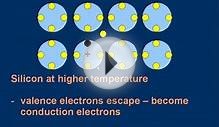 This work presents the development of n-type and p-type gas-sensitive materials from NiOx doped TiO2 thin films prepared by ion-assisted electron-beam evaporation. TiO2 gas-sensing layers have been deposited over a wide range of NiOx content (0–10 wt.%). The material analysis by atomic force microscopy, X-ray photoemission spectroscopy, and X-ray diffraction suggests that NiOx doping does not significantly affect surface morphology and Ni element may be a substitutional dopant of the TiO2 host material. Electrical characterization shows that NiOx content as high as 10% wt. is needed to invert the n-type conductivity of TiO2 into p-type conductivity. There are notable gas-sensing response differences between n-type and p-type NiOx doped TiO2 thin film. The responses toward all tested reducing gases tend to increase with operating temperature for the n-type TiO2 films while the response decreases with temperature for p-type TiO2 film. In addition, the p-type NiOx doping results in the significant response enhancement toward tested reducing gases such as acetone and ethanol at low operating temperature of 300 °C.
This work presents the development of n-type and p-type gas-sensitive materials from NiOx doped TiO2 thin films prepared by ion-assisted electron-beam evaporation. TiO2 gas-sensing layers have been deposited over a wide range of NiOx content (0–10 wt.%). The material analysis by atomic force microscopy, X-ray photoemission spectroscopy, and X-ray diffraction suggests that NiOx doping does not significantly affect surface morphology and Ni element may be a substitutional dopant of the TiO2 host material. Electrical characterization shows that NiOx content as high as 10% wt. is needed to invert the n-type conductivity of TiO2 into p-type conductivity. There are notable gas-sensing response differences between n-type and p-type NiOx doped TiO2 thin film. The responses toward all tested reducing gases tend to increase with operating temperature for the n-type TiO2 films while the response decreases with temperature for p-type TiO2 film. In addition, the p-type NiOx doping results in the significant response enhancement toward tested reducing gases such as acetone and ethanol at low operating temperature of 300 °C.
Keywords
- Titanium dioxide;
- Nickel oxide;
- Semiconductor gas sensor;
- Thin films;
- X-ray diffraction;
- X-ray photoelectron spectroscopy;
- Electron beam evaporation
RELATED VIDEO
